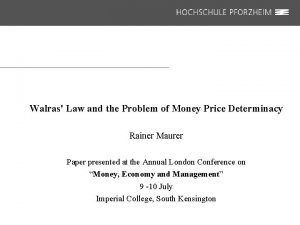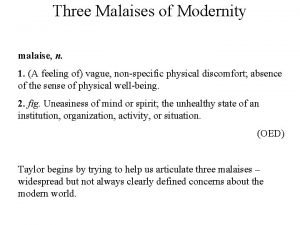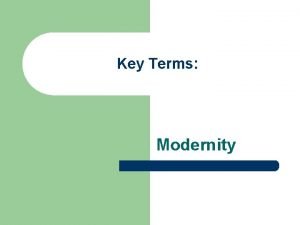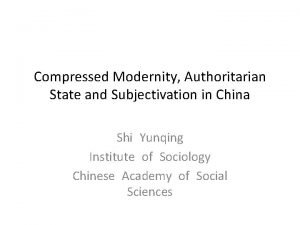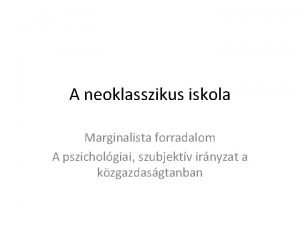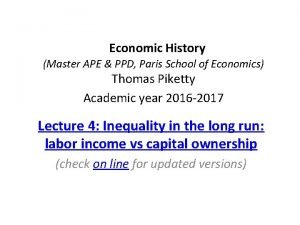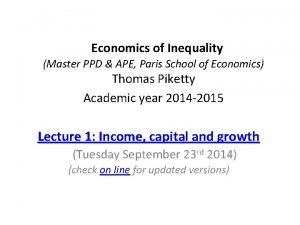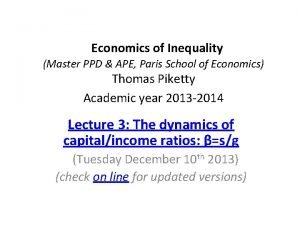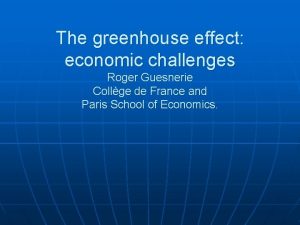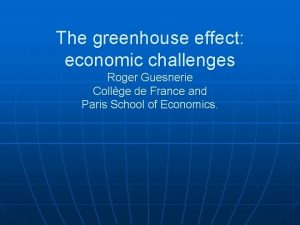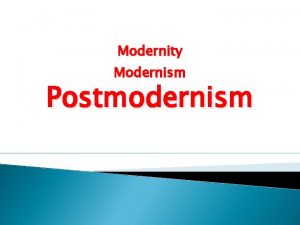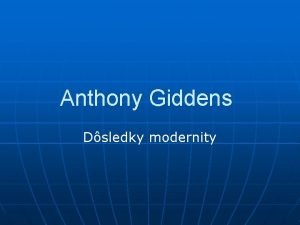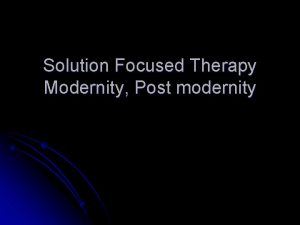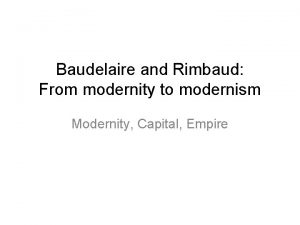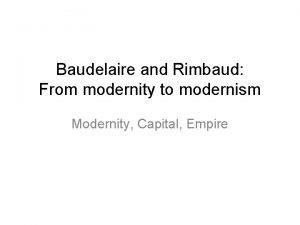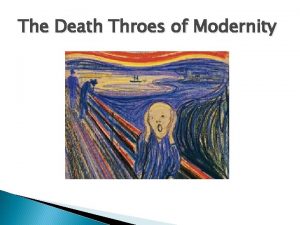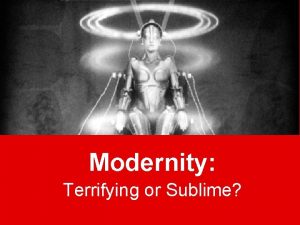The modernity of Walras Roger Guesnerie Paris School












- Slides: 12

The modernity of Walras. Roger Guesnerie Paris School of Economics Collège de France

Introduction n Is the prominent position attributed to Walras by Schumpeter… • Uncontroversial • Or questioned by modern developments ? n My viewpoint. • An outsider to history of economic thought… n (incomplete and random reading of Walras and others. . ) • A practitioner ! …of economic theory. n n Some work related with general equilibrium, with normative emphasis, (theoretical public economics), or somewhat connected (asymmetric information, expectational coordination) The argument. • The walrasian model subject to intensive critical light. . . • Remains a kind of « base camp » for reflection • Feeding programs that can be viewed as post-walrasian.

Modern theory and the Walras model : Achievements n Assesment from a « bourbakist’s eye » n n Transformation of the Walras model into the Arrow-Debreu (-Walras) model. A globally positive achievement Increase in generality…. • In terms of assumptions… • and scope n n n Intertemporal (Malinvaud-53), Uncertainty (Arrow-53. . 64) General version (Radner-70, Guesnerie-Jaffray-74. . ). Improved understanding • Of existence and multiplicity……. • Of connections n n The separability/allocation and redistribution issues wrong in non-convex settings. (G. Ema-1975) With oligop. comp. à la Cournot, (see G-Hart -1985)

Modern theory and the Walras model: Critical insights n « Internal » criticism : a misty global view n n n Questions on the effectiveness of the « tâtonnement process » algorithm / generate equilibrium prices Particularly spectacular: the Debreu-Mantel. Sonnenschein statement in exchange economies « External » criticism: stylisation under scrutiny n The demand in « stylized » markets. n n n A la A. Smith, Cournot, Dupuit, … Marshall and …Walras A critical assesment. • Introduction of search n Labour market. • Asymmetric information. n Credit market

The Walrasian model to-day ? . n Remained influential in many fields n Specific models • Sectoral emphasis (trade, . . ) • Policy emphasis (use of computable general equilibrium models) n Macroeconomics, • the post-war neo-classical synthesis n (mixed keynesian and walrasian considerations) • RBC models: W inter-temporal equilibrium. n n DGSE, new keynesian An unavoidable benchmark n to think about general equilibrium. …. And the interactions between markets n Example of 2 post-walrasian programs n

Post-walrasian program: 1 -the mechanics of price interactions n DMS an inappropriate pessimism ? n n n Debates on the actual relevance of the DMS result empirical estimation of demand does not support the possible DMS pessimism about the aggregate Price interactions an inappropriate setting ? • We live in production economies, where good prices are triggered by factor prices, in smaller number n Sraffa ? , Ekeland-G (2010). • Prices are quoted by firms, (or quantities) in an oligopolistic competition context. n n (as possibly described in new Keynesian models) What goes on not captured /W tâtonnement process.

Post-Walrasian program 2: Are expectations rational ? n The present « universal » story. • • n Agents face market conditions (prices) to-day, Guess market conditions (prices) to-morrow. What about guesses ? The REH Muth the relevant economic theory n n Economic agents do not make systematic mistakes They make the best predictions / their information Use the « relevant » economic theory. The REH has taken over all fields: • • General equilibrium, Macro. Specialized fields, IO, trade, …. Finance

Post-Walrasian program 2: Are expectations rational ? n Obvious critical remarks. • Prices delivered to-day critically under scrutiny, (tâtonnement)? • But their value to-morrow easily guessed. • Is it rational to have RE ? The answer is no n Poincaré letter to Walras : • « Vous faîtes l’hypothèse que les agents sont infiniment égoistes, ce qui est sans doute acceptable en première approximation, mais aussi qu’ils sont infiniment clairvoyants, ce qui est beaucoup plus discutable. . » • « You assume that agents are infinitely selfish, which may be acceptable, as a first approximation, but also that they are infinitely clairvoyant, which is much more debatable »

Directions for a critical assesment of the REH. n Upstream Remarks: n Problems when multiple REE n n Locally, or in case /uniqueness, questions on (local, global) expectational robustness of the equilibrium. « Eductive » learning. n n Critical assesment of the Muthian argument…. (Common) Knowledge of the (aggregate) actions. • Assessing Rational Expectations : the « eductive » viewpoint, MIT Press G. 2006 n « Real time » learning. n n n A bounded rationality viewpoint. Adaptive learning, etc…(Evans-Honkappohja, 2001) Other. n Rejection of the hypothesis of CK of the exogenous uncertainty (Kurz)

The Muth model : the « eductive » viewpoint n n A collective « cognitive » process • CK : P < pmax • Evbd knows that n S(f) < S(pmax, f) n S< S(pmax, f)df n p>D(-1) 0 S = p 1 n Then n S> S(p 1, f)df • If evbd knows that evbd knows : n evbd knows that n p< D(-1) 0 S(p 1) = p 2. . Etc conclusion Cvgce iif C<B q B A-Bp Cp C p 0 p

Comparison with Evolutive learning. alpha p(e, t, t+1)= p(t)+(1 - )p(e, t-1, t) C/B

Insigths: the eductive research program n The Muth model: n n n Partial equilibrium: n n n For eductive stab. the sensitivity of savings to expectations, (as well as the keynesian multiplier!. . and price flexibility) matter. Trade extension affect exp. Stability. RBC are not « eductively » stable OLG models. n n n Futures markets improve eq. char. , but decrease exp. robustness Markets are not stable when they transmit too much information. More competitors may incr. efficiency /detriment of exp. stability. General equilibrium: n n Global eductive robustness __all adaptive learnig rules converge ___ supply elasticity not too large __better if sequential decisions. Eductive st. more demanding / determinacy, absence of sunspot The « eductive » policy rule more demanding than the Taylor rule. Ben Porath, Calvo, Evans, Desgranges, Gaballo, Gauthier, Geoffard, Goyal, Guesnerie, Heinemann, Negroni, Mc Gough, Rochet, Woodford….
